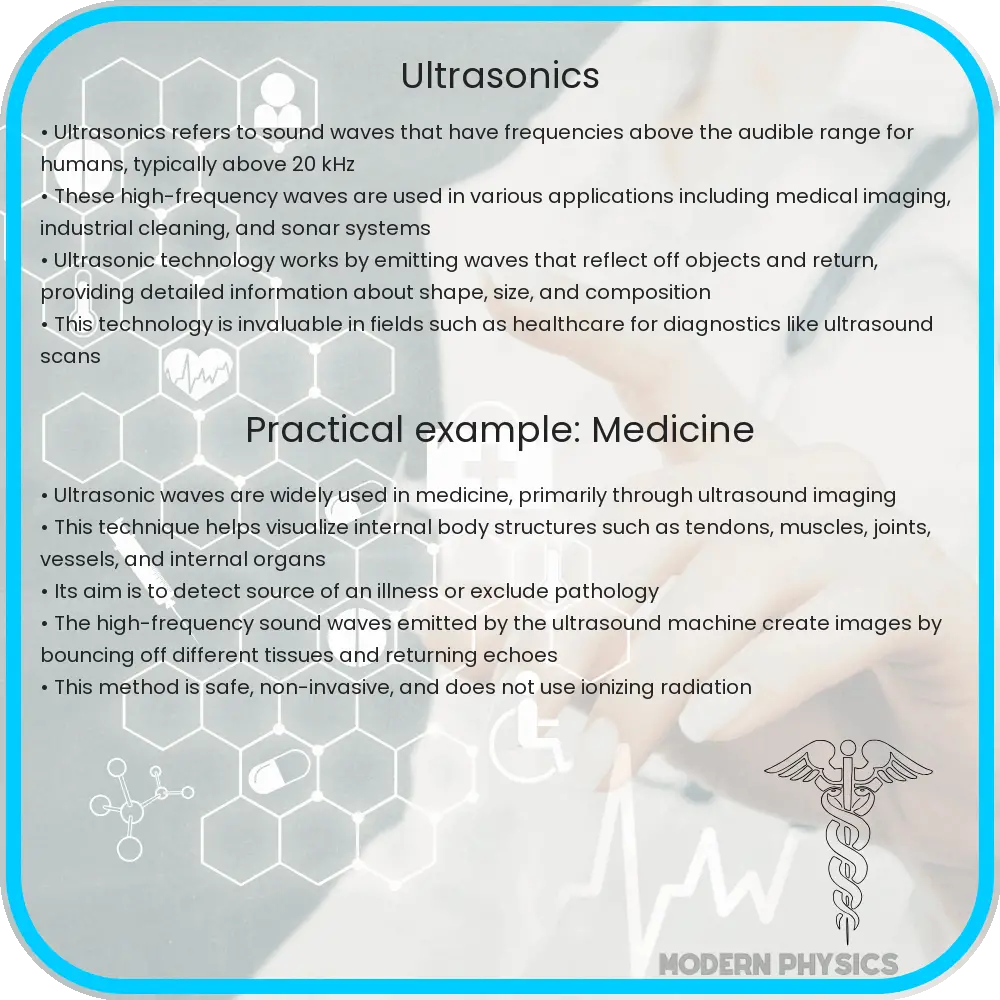Explore the science of ultrasonics, a branch of acoustics focusing on sound waves above 20 kHz, and its diverse applications across various fields.

Introduction to Ultrasonics in Acoustics
Ultrasonics, a subfield of acoustics, deals with sound waves at frequencies beyond the upper limit of human hearing, typically above 20 kHz. This realm of high-frequency sound waves opens up a myriad of applications across various fields, from medical imaging to industrial cleaning. Understanding the basic physics behind ultrasonics can offer insights into how these invisible waves can be harnessed for practical and innovative uses.
The Nature of Ultrasonic Waves
Like all sound waves, ultrasonic waves are mechanical waves that propagate through a medium (such as air, water, or solids) by the vibration of particles. What distinguishes ultrasonic waves from audible sound waves is their frequency. Human hearing ranges from about 20 Hz to 20 kHz, and any sound wave with a frequency above this range falls into the category of ultrasonics.
The frequency of a wave is inversely proportional to its wavelength. This can be expressed by the equation:
\[ \text{Wavelength} (\lambda) = \frac{\text{Velocity of sound} (v)}{\text{Frequency} (f)} \]
Where λ is the wavelength, v is the speed of sound in the medium, and f is the frequency of the wave. Due to their higher frequencies, ultrasonic waves have much shorter wavelengths compared to audible sound. This property allows them to be used for imaging purposes, as they can provide greater resolution by detecting smaller details within a medium.
Generation of Ultrasonic Waves
Ultrasonic waves are typically generated using piezoelectric materials, which convert electrical energy into mechanical motion when an electrical voltage is applied. These materials effectively generate and pick up ultrasonic waves, making them invaluable for both transmitting and receiving ultrasonic signals in devices like ultrasound machines.
In these applications, a piezoelectric transducer can be used to emit ultrasonic waves and then receive the echoes that are reflected back from various internal structures—be it bodily tissues or materials in non-destructive testing (NDT). The data collected can then be used to construct images or inform condition monitoring processes.
Applications of Ultrasonics
Ultrasonics has a broad range of applications, reflecting its versatility and effectiveness. Some key areas include:
- Medical Imaging: In medical imaging, particularly in ultrasound scans, high-frequency sound waves are used to create images of internal body structures such as organs, muscles, blood vessels, and even a fetus during pregnancy. This non-invasive method provides valuable medical information without the risks associated with ionizing radiation.
- Industrial Non-Destructive Testing (NDT): Ultrasonics is also employed in industry to test the integrity of materials and structures without damaging them. Ultrasonic testing can detect flaws such as cracks or voids inside materials, aiding in preventative maintenance and quality control.
- Cleaning: In the cleaning industry, ultrasonic cleaners use high-frequency sound waves to agitate a liquid, creating tiny bubbles whose collapse helps to dislodge dirt and debris from objects such as jewelry, lenses, and intricate machinery parts.
- Sonar: Another significant application is sonar (Sound Navigation and Ranging), used in underwater navigation and fish finding. Ultrasonics enables the detection of objects under water with fine resolution due to the sound waves’ ability to reflect off surfaces and return detailed information about distance and form.
Sonar systems are essential in maritime navigation, underwater exploration, and fisheries, underscoring the importance of ultrasonics in both practical and scientific applications beneath the waves. Next, we will further delve into the specifics of how these applications harness the power of ultrasonic waves to achieve impressive and necessary functions in numerous domains.
Detailed Insights into Specific Ultrasonic Applications
Each application of ultrasonic technology harnesses its unique properties in different ways. For example, in medical imaging, the high resolution facilitated by ultrasonic waves allows healthcare professionals to observe minute details in the human body. The short wavelength of these waves is crucial for creating clear images that can lead to accurate diagnoses.
In the field of industrial non-destructive testing (NDT), technicians use ultrasonic testing equipment to send waves through materials like metals and composites. These waves reflect back to the surface when they encounter discontinuities such as fractures or inclusions. Analyzing these echo patterns helps in identifying defects without causing any damage to the material being inspected.
Similarly, ultrasonic cleaners create high-frequency vibrations in a liquid, which causes cavitation bubbles to form and implode. The force generated by these implosions removes contaminants from objects submerged in the cleaning solution. This method is highly effective for cleaning complex mechanical assemblies and delicate items, ensuring thorough cleanliness without the risk of mechanical wear and tear.
Sonar systems differ slightly in their operation but still rely on the high frequency of ultrasonic waves. By transmitting sound waves and measuring their reflection off other objects and creatures, sonar systems can map surroundings, detect obstacles, and even assist in complex navigation challenges underwater.
Environmental and Safety Considerations
While ultrasonics offers significant benefits, it is also important to consider its environmental and safety impacts. High-intensity ultrasonic waves can potentially cause harm to marine life and small animals sensitive to high-frequency sounds. In medical and industrial applications, safety regulations are crucial to ensure that ultrasonic devices are used in ways that do not negatively affect human health or the environment.
As technology advances, engineers and scientists are continuously working on ways to mitigate any adverse effects associated with ultrasonic waves while maximizing their beneficial uses.
Conclusion
Ultrasonics, a fascinating branch of acoustics, plays a pivotal role in numerous applications ranging from medical diagnostics to underwater exploration. The technology leverages the unique properties of high-frequency sound waves to perform tasks that cannot be achieved through conventional means. Despite its broad utility, it is essential to use ultrasonic technology responsibly and ensure it is aligned with environmental and health safety standards. As we continue to develop and refine ultrasonic technologies, their potential to revolutionize various industries remains immense, promising even more innovative solutions in the future.
